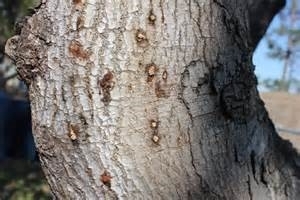Without a doubt the borers, PSHB and KSHB are going to hurt avocado production, but there are some California native and landscape trees that are also going to get hammered, like unto death. Much has been written about the borers in the press, from ag journals to environmental newsletters to newspapers, such as the New York Times, Los Angeles Times and more local papers like the Ventura Star and Riverside Press-Enterprise. Recent trap findings of PSHB in Ventura county brought a local gathering of community groups to discuss the situation and the need to get more information out to local residents of the major environmental disaster at our doorstep, It seems most homeowners are not aware of the problem or if so marginally so. Is it because it's viewed as just an avocado growers' problem? The CA Avocado Commission has lead in research and spending on this problem that will affect all citizens, not just growers and consumers of the fruit. Are we all just overwhelmed by the disasters that are occurring around us here and world-wide?
I'm not sure why the lack of general interest in this issue, but the only way to get control of these pests is to stop their movement, which is largely through humans moving contaminated wood. Slowing the spread will give time to develop control methods and measures that will allow our native woodlands to cope with this infestation. There are currently people looking for pathogens and parasites in the native range of these pests, in order to determine if those native control measure would fit into a California system. But this is going to take time and in the meantime the spread needs to be slowed. Talk to your neighbors, co-workers and friends. And have them talk to their neighbors, co-workers and friends. Get the word out about what we can all do to slow the spread.
Listed below are some of the common plants in which the borer can reproduce and spread its fungi that kill the tree. Many more trees have been identified to which the borer goes, but as yet it's not known whether the fungi spread in those trees.
Known Suitable Reproductive Host Trees of PSHB:
2. Big leaf maple (Acer macrophyllum)*
3. Evergreen Maple (Acer paxii)
4. Trident maple (Acer buergerianum)
5.Japanese maple (Acer palmatum)
6. Castor bean (Ricinus communis)
7. California Sycamore (Platanus racemosa)*
8. Mexican sycamore (Platanus mexicana)
9. Red Willow (Salix laevigata)*
10. Avocado (Persea americana)
11. Mimosa (Albizia julibrissin)
12. English Oak (Quercus robur)
13. Coast live oak (Quercus agrifolia)*
14. London plane (Platanus x acerifolia)
15.Cottonwood (Populus fremontii)*
16. Black cottonwood (Populus trichocarpa)*
17. White Alder (Alnus rhambifolia)*
18.Titoki (Alectryon excelsus)
19. Engelmann Oak (Quercus engelmannii)*
20. Cork Oak (Quercus suber)
21. Valley oak (Quercus lobata)*
22. Coral tree (Erythrina corallodendon)
23. Blue palo verde (Cercidium floridum)*
24. Palo verde (Parkinsonia aculeata)
25. Moreton Bay Chestnut (Castanospermum australe)
26. Brea (Cercidium sonorae)
27. Mesquite (Prosopis articulata)*
28. Weeping willow (Salix babylonica)
29. Chinese holly (Ilex cornuta)
30. Camelia (Camellia semiserrata)
31. Acacia (Acacia spp.)
32. Liquidambar (Liquidambar styraciflua)
33. Red Flowering Gum (Eucalyptus ficifolia)
34. Japanese wisteria (Wisteria floribunda)
35. Goodding's black willow (Salix gooddingii)*
36. Tree of heaven (Alianthus altissima)
37. Kurrajong (Brachychiton populneus)
38. Black mission fig (Ficus carica)
Known Suitable Reproductive Host Trees of KSHB
1. Avocado (Persea americana)
2. California Sycamore (Platanus racemosa)*
3. Coast live oak (Quercus agrifolia)*
4. Cork oak (Quercus suber)
5. Draft coral tree (Erythrina humeana)
- Black Polar (Populus nigra)
7. Black locust (Robinia pseudoacacia)
8. Red Willow (Salix laevigata)*
- Arroyo willow (Salix lasolepis)*
- Cottonwood (Populus fremontii)*
11. Mimosa (Albizia julibrizin)
12. Castor bean (Ricinus communis)
13. Black Willow (Salix nigra)*
14. Strawberry Snowball Tree (Dombeye cacuminum)
*Native species to California
For other information sources of what these new borers can do to our wildscapes check out:
http://ucanr.edu/sites/socaloakpests/
Attached Images:
